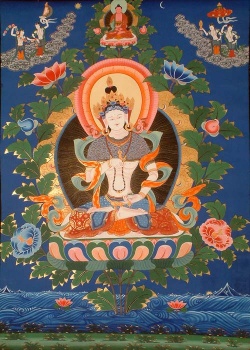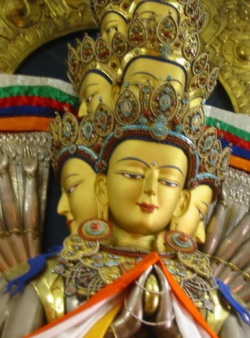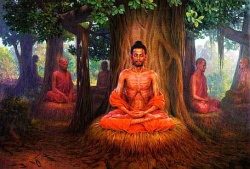Difference between revisions of "Tengyur"
| Line 61: | Line 61: | ||
[[Category:Buddhism]] | [[Category:Buddhism]] | ||
[[Category:Tibet]] | [[Category:Tibet]] | ||
| − | |||
{{TibetanTerminology}} | {{TibetanTerminology}} | ||
Latest revision as of 07:00, 16 May 2023
Tengyur, collection of commentaries.
The Tengyur or Tanjur is the Tibetan collection of commentaries to the Buddhist teachings, or "Translated Treatises". The Beijing version covers 3,626 texts in 224 volumes, but numbers vary depending on the version.
The Buddhist Canon
To the Tengyur were assigned commentaries to both Sutras and Tantras, treatises and abhidharma works (both Mahayana and non-Mahayana).
Together with the 108-volume Kangyur (the Collection of the Words of the Buddha), these form the basis of the Tibetan Buddhist canon. "The Kangyur usually takes up a hundred or a hundred and eight volumes, the Tengyur two hundred and twenty-five, and the two together contain 4,569 works."
As example, the content of the Beijing Tengyur:
Sutras ("Hymns of Praise"): 1 Volume; 64 texts.
Commentaries on the Tantras: 86 Volumes; 3055 texts.
Commentaries on Sutras; 137 Volumes; 567 texts.
Prajnaparamita Commentaries, 16 Volumes.
Madhyamika Treatises, 29 Volumes.
Yogacara Treatises, 29 Volumes.
Abhidharma, 8 Volumes.
Miscellaneous Texts, 4 Volumes.
Vinaya Commentaries, 16 Volumes.
Tales and Dramas, 4 Volumes.
Technical Treatises, 43 Volumes.
The Bon Tengyur
The Tibetan Bön religion, under the influence of Buddhism, also has its canon literature divided into two sections called the Kangyur and Tengyur but the number and contents of the collection are not yet fully known. Apparently, Bon began to take on a literary form about the time Buddhism began to enter Tibet.
Tengyur (Wyl. bstan 'gyur) – the commentaries on the teachings of the Buddha. The Tibetan Buddhist Canon is divided into the actual words of the Buddha contained in the Kangyur, and the treatises composed by the learned and accomplished masters of India, which are contained in the Tengyur.
Ringu Tulku Rinpoche has said:
"All the teachings in Buddhism are divided into two types: the direct teaching of the Buddha and the commentaries. The teachings that come directly from the Buddha are called sutras in Sanskrit and Kangyur in Tibetan. You might call them the scriptural or canonical teachings. The commentaries are called shastras in Sanskrit and tenchö in Tibetan. In Tibetan, this Kangyur is 108 volumes, and the Tengyur, the translation of the commentaries that come from India, is 228 volumes. The commentaries written later on by Tibetans and others can also be called tenchö."
Major Editions
Choné Tengyur
Dergé Tengyur
Golden Tengyur
Narthang Tengyur


